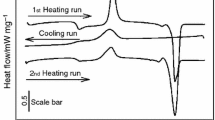Abstract
In the paper are presented the studies of the effect of glass transition temperature of new water-thinnable polymeric binders on the properties of ceramic materials obtained by die pressing. The parameters of ceramic samples comprising polymeric binders have been compared with those of samples comprising poly(vinyl alcohol) (PVA) — water-soluble binder. When using poly(acrylic-styrene) (AS), poly(acrylic-allyl) (AA) and poly(vinyl-allyl) (VA) water-thinnable binders, materials of greater density and mechanical strength were obtained in the green state as well as after sintering than those in the case of using PVA. The dependence of the chemical structure of the binders applied on the properties of samples such as the glass transition temperature and hydrophobic-hydrophilic balance of the copolymers has been discussed.
Similar content being viewed by others
References
S. L. Bassner and E. H. Klingenberg, Am. Cer. Soc. Bull., 77 (1998) 71.
Y. Zhang, T. Suga, M. Kawasaki, X. Tang, N. Uchida and K. Uematsu, J. Am. Cer. Soc., 79 (1996) 435.
R. Moreno, Am. Cer. Soc. Bull., 71 (1992) 1647.
M. Szafran, G. Rokicki and P. Wisniewski, Polish Ceramic Bulletin, Ceramika, 60 (2000) 229.
M. Szafran and G. Rokicki, J. Am. Cer. Soc., 84 (2001) 1231.
M. Szafran, P. Wisniewski, G. Rokicki and L. Łukasik, J. Therm. Anal. Cal., 66 (2001) 603.
M. Szafran, G. Rokicki and P. Wisniewski, NATO Book Series ‘Functional Gradient Materials and Surface Layers Prepared by Fine Particles Technology’, Kluwer, The Netherlands 2001, p. 75.
K. M. Picker, J. Therm. Anal. Cal., 73 (2003) 597.
J. E. K. Schawejuergen and U. Hess, J. Therm. Anal. Cal., 68 (2002) 741.
H. Hatakeyama, J. Therm. Anal. Cal., 70 (2002) 755.
T. Ozawa, J. Therm. Anal. Cal., 56 (1999) 691.
J. Dweck, J. Therm. Anal. Cal., 60 (2000) 785.
T. Ozawa, J. Therm. Anal. Cal., 59 (2000) 257.
V. B. F. Mathot, J. Therm. Anal. Cal., 64 (2001) 15.
M. Taniguchi, J. Therm. Anal. Cal., 64 (2001) 177.
R. Riesen, J. Therm. Anal. Cal., 64 (2001) 243.
J. M. Hutchinson, J. Therm. Anal. Cal., 72 (2003) 619.
P. Wisniewski, M. Szafran, G. Rokicki, M. Molak and D. Jach, Polish Ceramic Bulletin, Ceramika, 80 (2003).
W. M. Recko, ‘Weibull modulus, history and future’, 4th Conference of Polish Ceramic Society, Conference Materials, Zakopane, 25–28 September, 2003.
Author information
Authors and Affiliations
Corresponding author
Rights and permissions
About this article
Cite this article
Szafran, M., Wisniewski, P. & Rokicki, G. Effect of glass transition temperature of polymeric binders on properties ceramic materials. Journal of Thermal Analysis and Calorimetry 77, 319–327 (2004). https://doi.org/10.1023/B:JTAN.0000033216.99303.33
Issue Date:
DOI: https://doi.org/10.1023/B:JTAN.0000033216.99303.33




